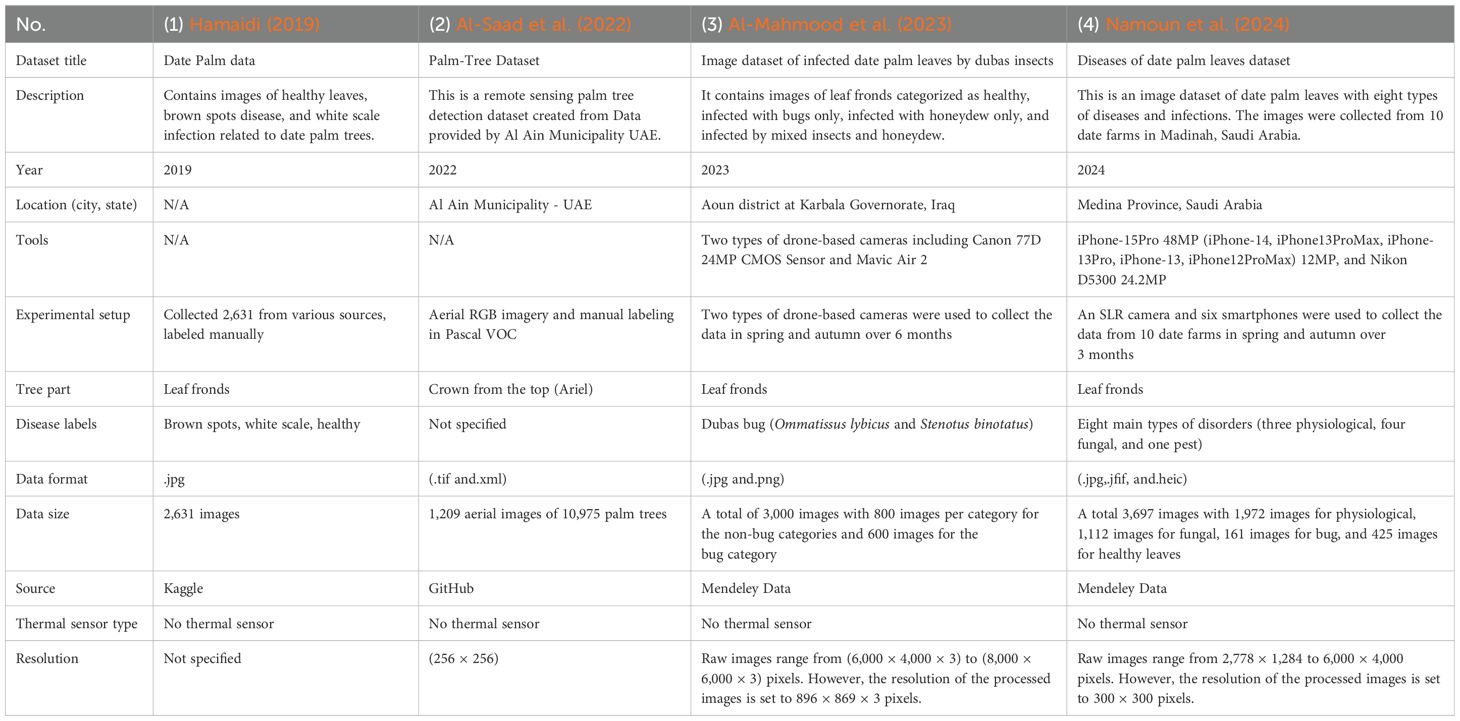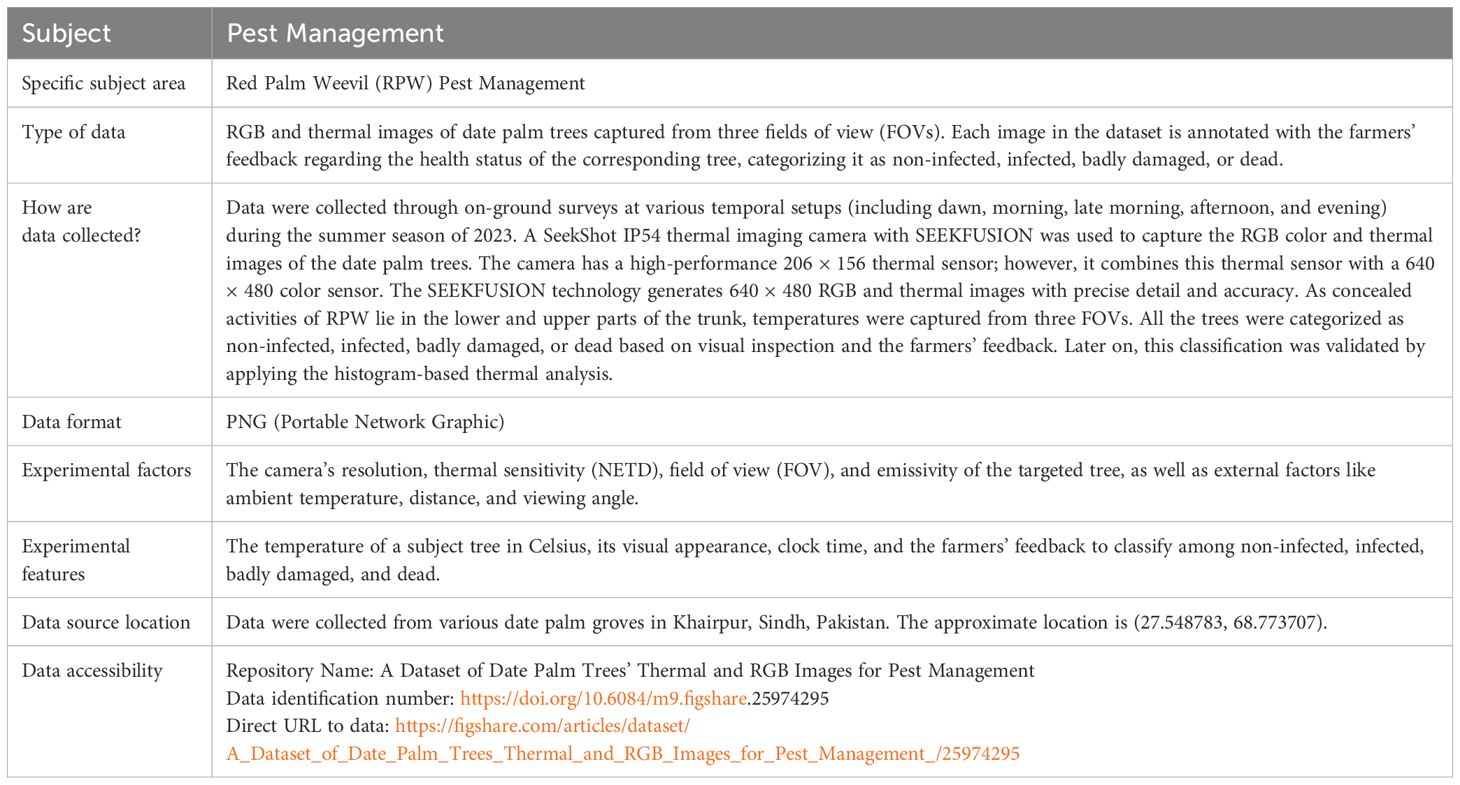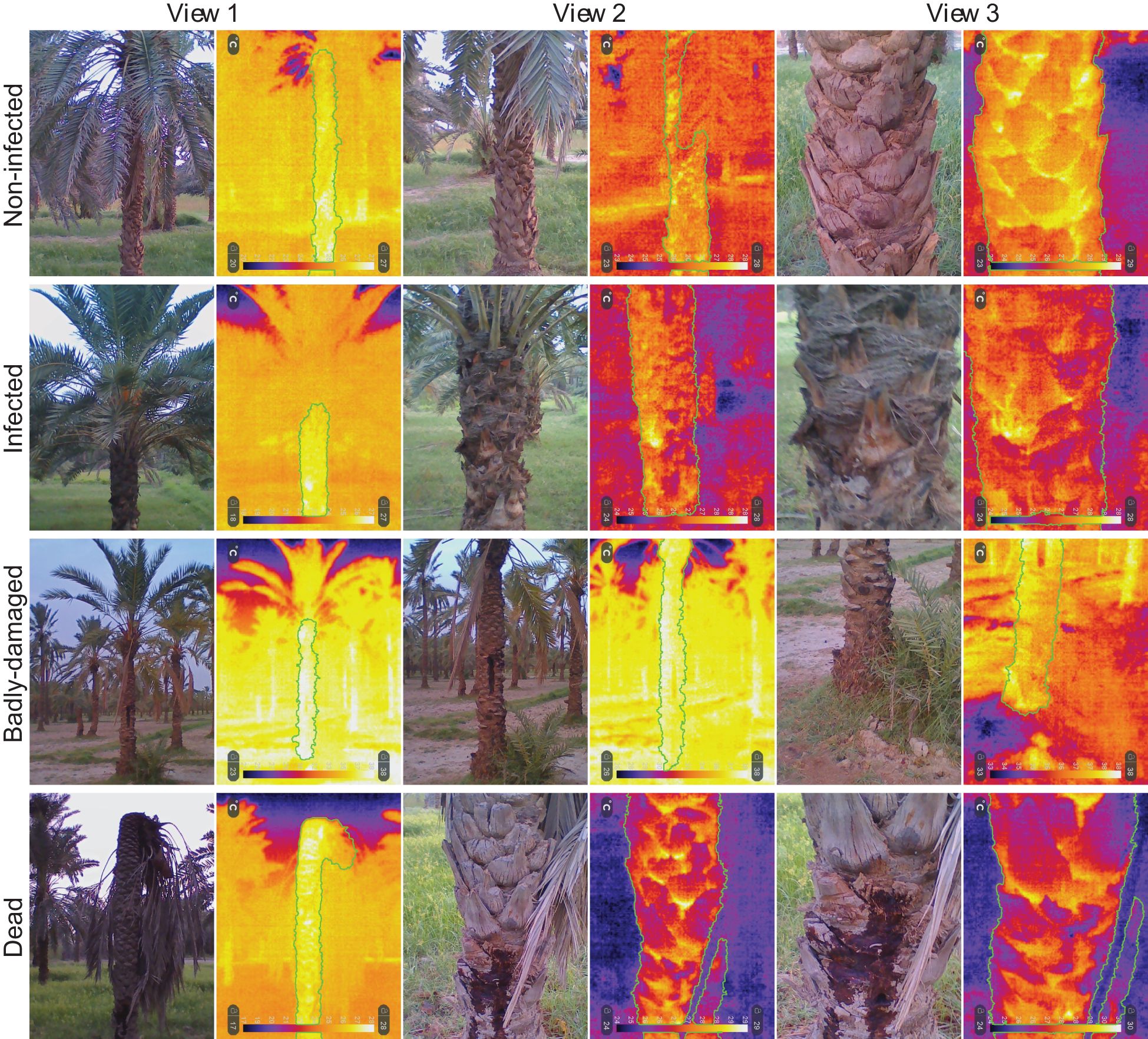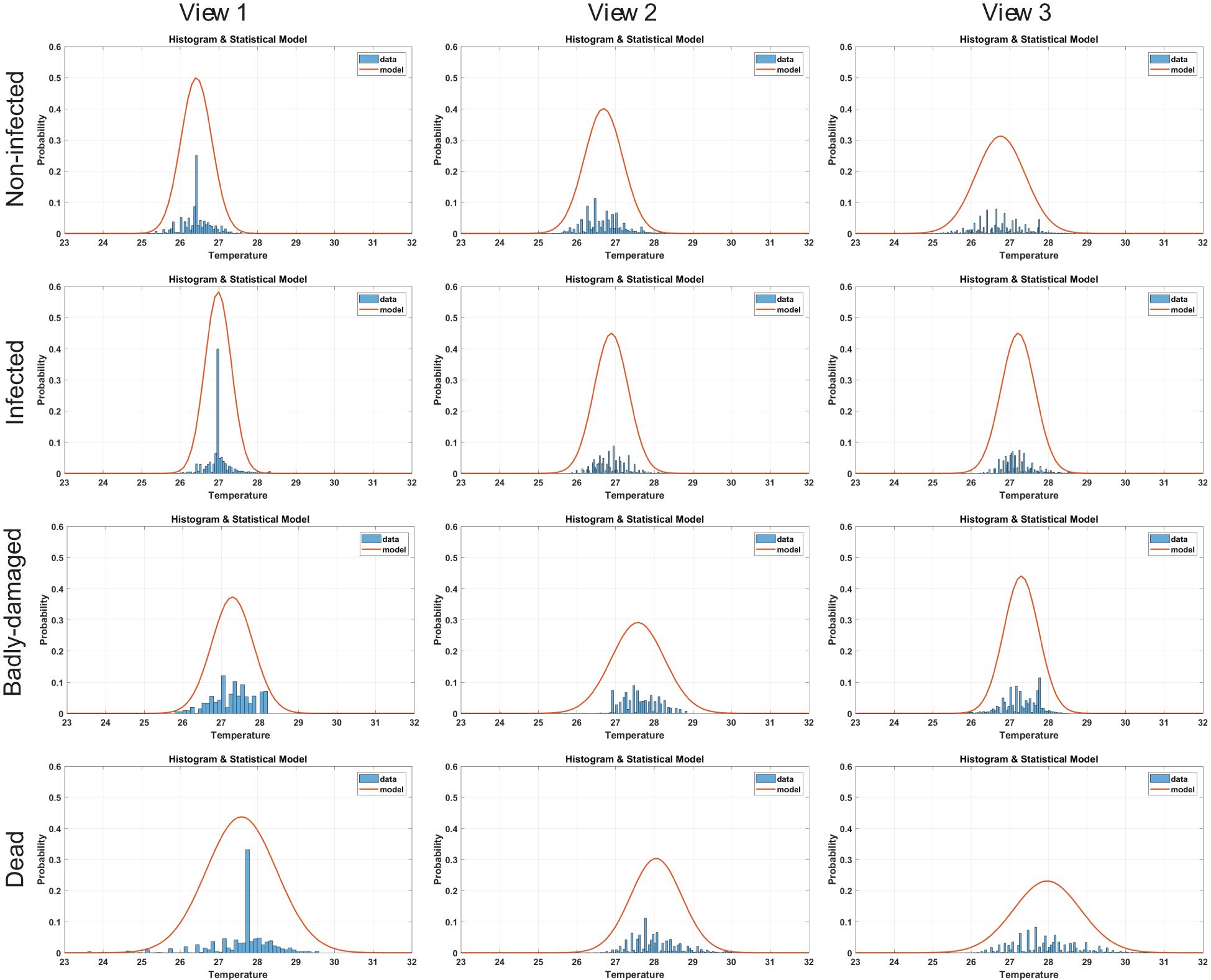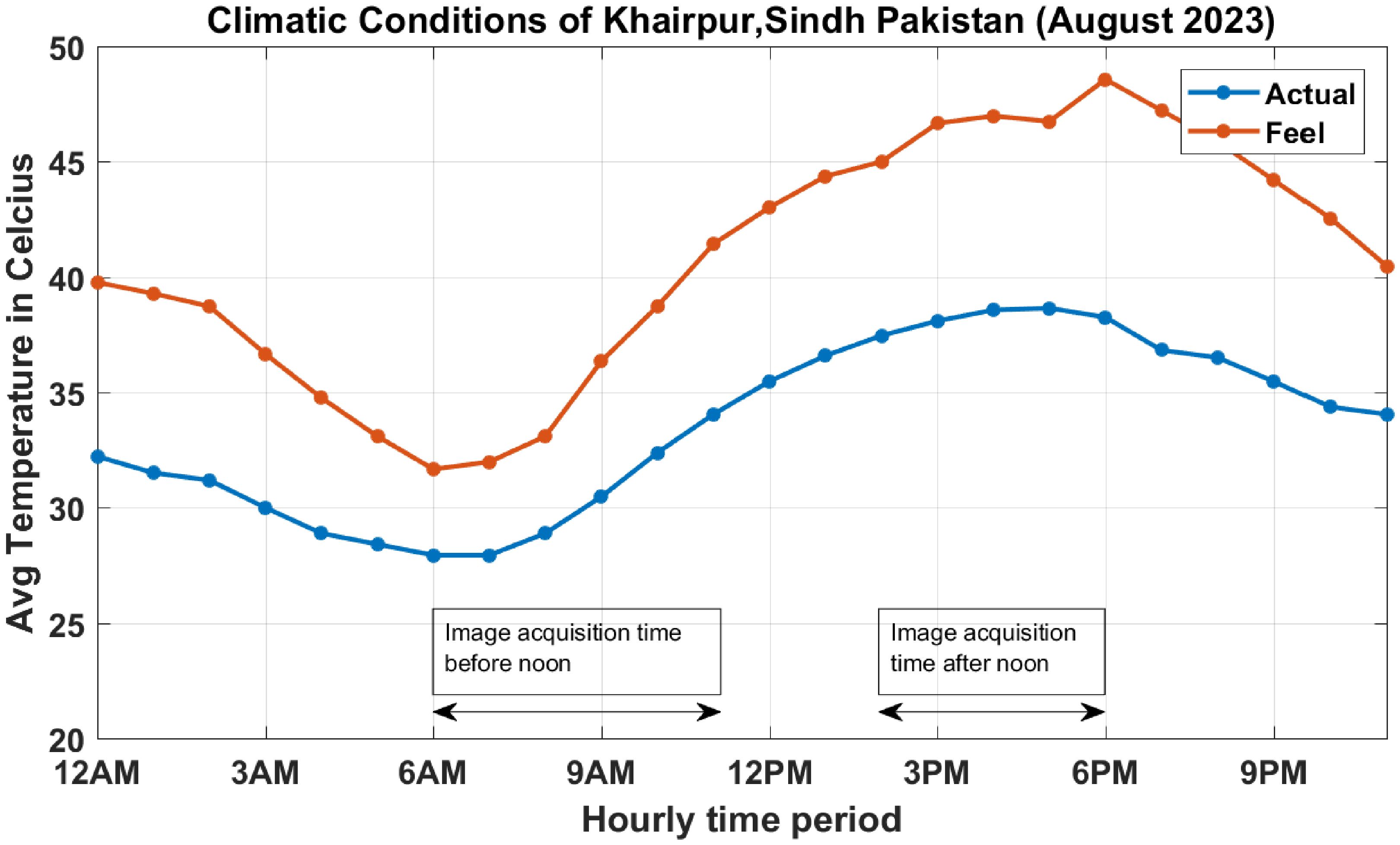- 1Faculty of Computer and Information Systems, Islamic University of Madinah, Madinah, Saudi Arabia
- 2Department of Physics, Federal Urdu University of Arts, Science and Technology, Karachi, Pakistan
- 3Department of Computer Science, Al-Kawthar University, Karachi, Pakistan
- 4Department of Computer Science, Federal Urdu University of Arts, Science and Technology, Islamabad, Pakistan
The primary objective of this article is to present a comprehensive dataset for controlling and monitoring red palm weevil (RPW) (Rhynchophorus ferrugineus) infestation. For this purpose, several digital and thermal images of date palm trees (Phoenix dactylifera L.) have been captured from various date palm groves in Khairpur, Sindh, Pakistan. Each image in the dataset is annotated with the farmers’ feedback regarding the health status of the corresponding tree, categorizing it as non-infected, infected, badly damaged, or dead. This dataset aims to facilitate (1) RPW pest management and (2) the development and evaluation of machine learning algorithms for automated date palm tree classification by providing a diverse collection of images and groundtruth labels. It contains 832 images (RGB and thermal) collected through the onground survey in date palm fields, which are classified based on visual inspection and the farmers’ feedback. A neural network-based thermal analysis is made, which validates the initial classification. The dataset shows promising potential for further studies, supporting a wide range of research topics extending the body of knowledge. It is valuable for researchers, industry professionals, public authorities, and others interested in harvesting date palm trees.
1 Introduction
The date palm trees are revered for their nutritious and high-energy fruits. They are drought-tolerant and thrive in hot, arid regions. Each tree has a single sturdy trunk covered with persistent leaf bases. The male tree produces pollen while the female tree bears fruit. The date palm trees (Phoenix dactylifera) are of significant economic and cultural importance in various regions worldwide, particularly in arid and semi-arid climates like those found in Khairpur, Sindh, Pakistan. However, these trees are susceptible to the red palm weevil (RPW) pest, bayoud disease, and environmental stresses that adversely affect their productivity and overall health. Timely detection and management of these issues are crucial for sustainable date palm cultivation. The date palm is a nutritious and high-energy fruit consumed globally. According to statistics from Nationmaster (2020), Pakistan ranks as the sixth-leading producer and consumer of dates worldwide. Remote sensing techniques, including RGB and thermal imaging, offer a non-invasive and efficient means of monitoring plant health and detecting stress factors. RGB imaging provides visual information about the foliage and appearance of date palm trees, while thermal imaging offers insights into their physiological status by measuring the trunk and crown temperature variations. Integrating these two modalities can enhance the accuracy and reliability of plant health assessment.
El-Habbab et al. (2017) demonstrated the effectiveness of remote sensing technologies for monitoring plant health and detecting stress factors in various crops, including date palm trees. A review by Alsadik et al. (2024) explored UAV-based remote sensing for monitoring and managing pests and diseases in date palms, highlighting sensor technologies (RGB, multispectral, hyperspectral, thermal, and LiDAR), vegetation indices, and machine learning integration for accurate detection. It outlines future directions to enhance UAV applications in palm health management. Similarly, Al-Mulla and Al-Ruehelli (2020) explore the use of airborne remote sensing, including VHR satellite imagery and UAVs, to detect pest infestations in Oman’s 7.6 million date palm trees, a vital crop covering 35% of the agricultural area. Focused on the Sultan Qaboos University farm, the research identified a new disease through its unique spectral signature in the large-scale detection of infected trees using multispectral and high-resolution RGB drone imagery.
NationMaster provides the statistical data on date production in Pakistan from 1991 to 2019, highlighting a consistent pattern of decline from 2002 to 2019. Meanwhile, the annual consumption of dates has been significantly increasing since 2005, indicating a growing imbalance between production and consumption. The decrease in production is primarily attributed to water scarcity and inappropriate pest management. The local farmers rely on manual methods for identifying infected trees through on-ground routine surveys, which are inefficient and sometimes delayed, allowing pests to spread to nearby trees. This late detection causes the need for timely identification and intervention to prevent further damage. This study emphasizes the critical importance of early detection to mitigate the spread of pests and preserve healthy trees. Therefore, decision-making requires a comprehensive and dependable dataset.
Table 1 shows that Hamaidi (2019) published the dataset named “Date Palm data,” which encompasses a collection of 2,631 images capturing various aspects of date palm health, including healthy leaves, brown spots disease, and white scale infection, which contain 1,203, 470, and 958 files, respectively. In contrast, Al-Saad et al. (2022) Palm-Tree-Dataset focuses on remote sensing data tailored for palm tree detection, primarily for research and educational purposes, with specific emphasis on Al Ain Municipality in the UAE. Similarly, “Image dataset of infected date palm leaves by dubas insects” in Al-Mahmood et al. (2023) offers digital images of infected and uninfected palm fronds. The palm fronds are categorized into (1) healthy palm leaves; (2) leaves infected by dubas bug; (3) leaves infected by honeydew; and (4) leaves infected by both dubas bug and honeydew. The images of the leaves that the insects infect include different stages of an insect’s life cycle, ranging from the third generation of nymphs to the adult stage in the fifth stage of the nymph. All the images are collected from a distance of 0.5 to 2 m. The dataset of infected date palm leaves for palm tree disease detection and classification (Namoun et al., 2024) also offers digital images of infected and uninfected palm fronds. It covers eight main types of palm tree disorders broadly categorized as physiological, fungal, and insect. Mineral deficiencies such as magnesium (Mg-), manganese (Mn-), and potassium (K-) exhibit physiological symptoms. Similarly, black scorch, leaf spots, fusarium wilt, and rachis blight exhibit fungal symptoms. It also includes the leaves infected by the parlatoria blanchardi bug. Ammar et al. (2021) collected 10,000 aerial images of date palm trees and then devised a deep-learning-based framework for auto-counting and geolocating the date palm trees through aerial imaging.
Each dataset varies in scope, focus, and geographical context, catering to distinct research needs within the date palm tree monitoring and analysis domain. These datasets only cover leaf frond diseases, which can be recorded with a digital camera. However, a digital camera is not capable of getting insight into concealed activities in tree trunks. We did not find any comprehensive dataset that provides sufficient insight into the RPW infestation that causes severe damage to the internal structure of a date palm tree. Some authors, including Alaa et al. (2020) and Nadeem et al. (2023), provide very few thermal images of RPW infestation, which are insufficient to facilitate the study and development of detection methods for this destructive pest. Therefore, a comprehensive dataset of thermal and digital images is necessary to cope with the problem.
This article presents a comprehensive dataset for controlling and monitoring the RPW infestation. The dataset aims to facilitate (1) RPW pest management and (2) the development and evaluation of machine learning algorithms for automated date palm tree classification by providing a diverse collection of images and ground-truth labels. It contains 832 images (RGB and thermal) collected through the on-ground survey in date palm fields. Each image in the dataset is annotated with the farmers’ feedback regarding the health status of the corresponding tree, categorizing it as non-infected, infected, badly damaged, or dead. A neural network-based thermal analysis is made to validate the initial classification; further investigation of this dataset is left for users as future endeavors. The dataset shows promising potential for further studies, supporting a wide range of research topics extending the body of knowledge. It is valuable for researchers, industry professionals, public authorities, and others interested in harvesting date palm trees.
2 Dataset description
The dataset was particularly developed for RPW pest management. All the thermal and color images were collected from 179 trees, which we selected from various date palm groves in Khairpur, Sindh, Pakistan. These trees were categorized into four classes—non-infected (80 trees), infected (32 trees), badly damaged (12 trees), and dead (55 trees)—based on visual inspection and the farmers’ feedback in the field. We could find these trees with the help of a local navigator, who contacted local farmers and then led us to the various date palm groves for data collection. Some infected trees were deep inside the groves, while others were on the borders. Some of the infected trees were at the initial stages of the RPW infestation, and their physical appearance was quite normal due to the minimal damage. We also visited a date palm grove where all the trees were badly damaged. We found no overlap of trees in any date palm grove. Local farmers there do not use technology; instead, they employ human labor to manage their various tasks in the field manually.
The dataset contains 832 processed images (RGB and thermal) of the Aseel cultivar, a predominant cultivar in Khairpur and Sukkur regions. Each image in the dataset is annotated with the farmers’ feedback regarding the health status of the corresponding tree, categorizing it as non-infected, infected, badly damaged, or dead. Table 2 briefly describes the specifications of the dataset. A few sample images are presented as an example in Figure 1, where the health status of the sample tree can be observed easily. This dataset serves as a valuable resource for researchers and practitioners working on precision agriculture and plant health monitoring by providing a diverse collection of images along with segregated folders. Future research endeavors can leverage this dataset to develop and evaluate machine learning algorithms for automated date palm tree classification and disease detection, ultimately contributing to the advancement of sustainable agriculture practices and food security in arid regions.
Each tree in the dataset has a single sturdy trunk covered with persistent leaf bases, which form a thick coat that protects the bundles of vascular tissue in the tree trunk. These vascular bundles contain the tissues of xylem and phloem, where xylem transports the minerals and water to the aerial part of the tree, and phloem transports carbohydrates from the source to the sink. When a date palm tree is infested, the larvae inside the trunk gradually damage the vascular tissue bundles, which degrade the tree’s efficacy for water utilization. This degradation leads the infected tree to a severe infection level where the recovery of that tree becomes impossible; hence, the tree finally dies. As the concealed damages gradually increase from an initial level to the final severe stage, internal fermentation raises the trunk’s temperature at damage points. Therefore, temperature profiles of the trunk’s surfaces can play a key role in pest management. We can use them to validate the initial classification based on visual inspection and the farmers’ feedback.
2.1 Temperature profiles
Thermal histograms can be used as the temperature profiles of thermal images; they are immune to the roughness of a thick coat on the trunk surface. The histograms of sampled images are presented in Figure 2, where a slight shift of the temperature envelope can be observed in temperature distributions. The distribution envelope slightly shifts towards the higher temperature if concealed fermentation rises due to the severity of internal damages. The temperature envelope of the dead and diseased trees shifts toward the right compared to the temperature envelope of the non-infected tree. Such information is very critical for conducting a comprehensive study on the health status of diseased date palm trees. The thermal analysis presented in Section 3.2.3 also supports the concept that thermal analysis can provide insight into the concealed activities in tree trunks. Minimum and maximum temperatures of a thermal image are required to compute its thermal histogram. Therefore, these values are provided for every thermal image in the dataset.
3 Methodology
The process involved several key steps, including image acquisition, annotation, and validation (see Figure 3a). RGB and thermal images were captured using a highly sensitive SeekShot IP54 thermal imaging camera, ensuring the comprehensive coverage of a date palm tree with three different fields of view (FOV), as shown in Figure 3b. Every selected tree was carefully observed before image acquisition, then its health status was inquired about from local farmers. After image acquisition, each image in the dataset was annotated with the farmers’ feedback regarding the health status of the corresponding tree, categorizing it as non-infected, infected, badly damaged, or dead. These annotations were carefully reviewed by the expert agronomists familiar with date palm cultivation and the domain knowledge.
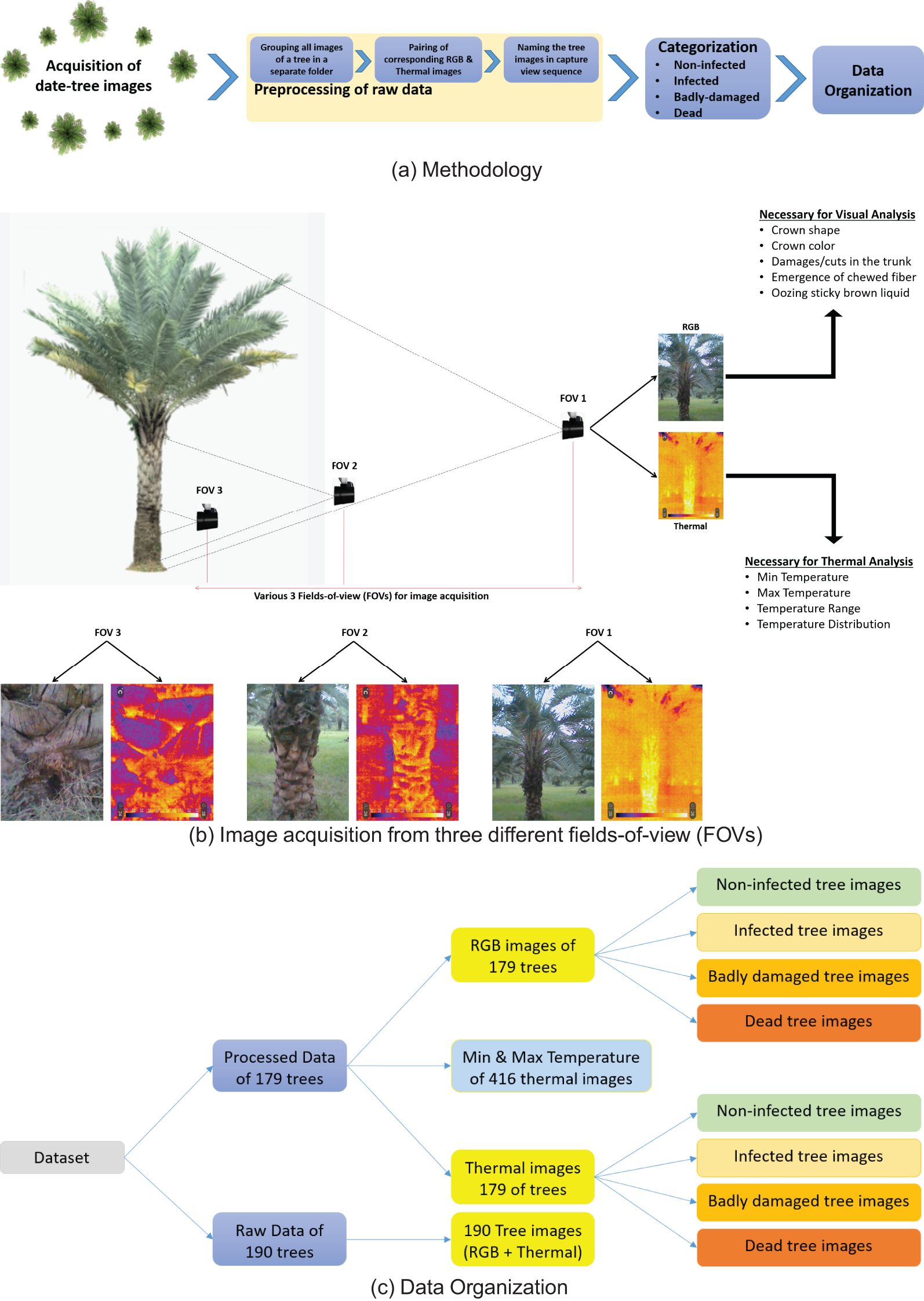
Figure 3. Experimentation setup of data gathering. (a) Methodology, (b) Image acquisition from three different fields-of-view, (c) data organization.
3.1 Annotation
Several online annotation tools exist for manually generating the trunks’ outlines, but we used interactive segmentation tools for precise outlines. The trunk outlines for sampled images are shown in Figure 1a, obtained using a region-based interactive segmentation tool. The Growcut (Vezhnevets and Konouchine, 2005) algorithm was employed for annotating tree trunks; however, other interactive segmentation algorithms, such as Cellular cut (Ashraf et al., 2017), can also perform accurate annotation.
3.2 Data collection framework
Special attention was paid to identifying the subtle signs of stem-boring beetles, such as leaf discoloration, wilting, and pest infestation. The initial framework regarding dataset collection consists of the following major steps:
1. Acquisition of RGB and thermal images;
2. Organization of raw data (tree-wise);
3. Preprocessing (grouping, pairing, and naming);
4. Categorization of data (based on visual parameters and the farmers’ feedback); and
5. Thermal analysis (validation of trees’ classification)
3.2.1 Acquisition of RGB and thermal images
RGB and thermal images were captured using a highly sensitive SeekShot IP54 thermal imaging camera, ensuring the comprehensive coverage of a date palm tree with three pre-defined FOVs, as shown in Figure 3b. Each image in the dataset was annotated with the farmers’ feedback regarding the health status of the corresponding tree, categorizing it as non-infected, infected, badly damaged, or dead.
Ambient temperature, sunlight irradiance, and background reflectance significantly affect the thermal readings; therefore, images were collected in five different time slots—dawn, morning, late morning, afternoon, and evening—to ensure diversity and representativeness. These time slots exhibit different climatic conditions as shown in Figure 4. Furthermore, efforts were made to capture images of date palm trees exhibiting a range of health conditions, from optimal growth to various degrees of stress and disease symptoms.
3.2.2 Preprocessing and organization
After raw data collection, all images of every tree were gathered in separate folders and then preprocessed and organized according to the hierarchy shown in Figure 3c. Every thermal image in the processed data has a corresponding color image in RGB color images. The computation of a thermal histogram requires the image’s minimum and maximum temperatures; therefore, these values are provided in a separate spreadsheet. The raw data are also presented in a separate folder.
3.2.3 Thermal analysis (validation of trees’ classification)
The analysis of thermal images mainly relies on thermal histograms, which cover all the parameters mentioned in Figure 3b. The histograms themselves or after further processing may construct unique feature vectors to form a new basis for accurately identifying the trees’ classes. We employed a pattern recognition tool for image classification. For this purpose, a neural network model with 20 neurons was constructed and then trained, where 70% of the feature vectors were used for training, 15% for validation, and 15% for testing. The trained network effectively recognizes their health conditions, classifying the date palm trees in their respective categories. The primary-level analysis of thermal histograms is shown in Figure 5, where a total of 416 thermal images were categorized in their respective classes. According to the “All Confusion Matrix,” 265 thermal images were truly classified, constituting 63.7% of 416 thermal images. The receiver operating characteristic (ROC) curves are also shown in Figure 5. According to these curves, the neural network performs well at various classification thresholds. The error histogram of the neural network is also shown in Figure 5, which visualizes the error between targets and outputs after the training. This analysis somewhat validates the initial classification, based on visual inspection and domain knowledge; however, further analysis can improve these results if segmentation masks for trunks are created and then applied to the analysis. Since the data were collected in five different time slots, the ambient temperature may be considered to get further improvements. Further analysis of this dataset is left for users as future endeavors. The abovementioned thermal analysis can be extended to a multi-modal domain, where digital and thermal features are combined to enhance the accuracy of the prediction analysis. This improvement is critical for paste management in actual fields on a large scale; therefore, a larger and more comprehensive study should be conducted to achieve this goal.
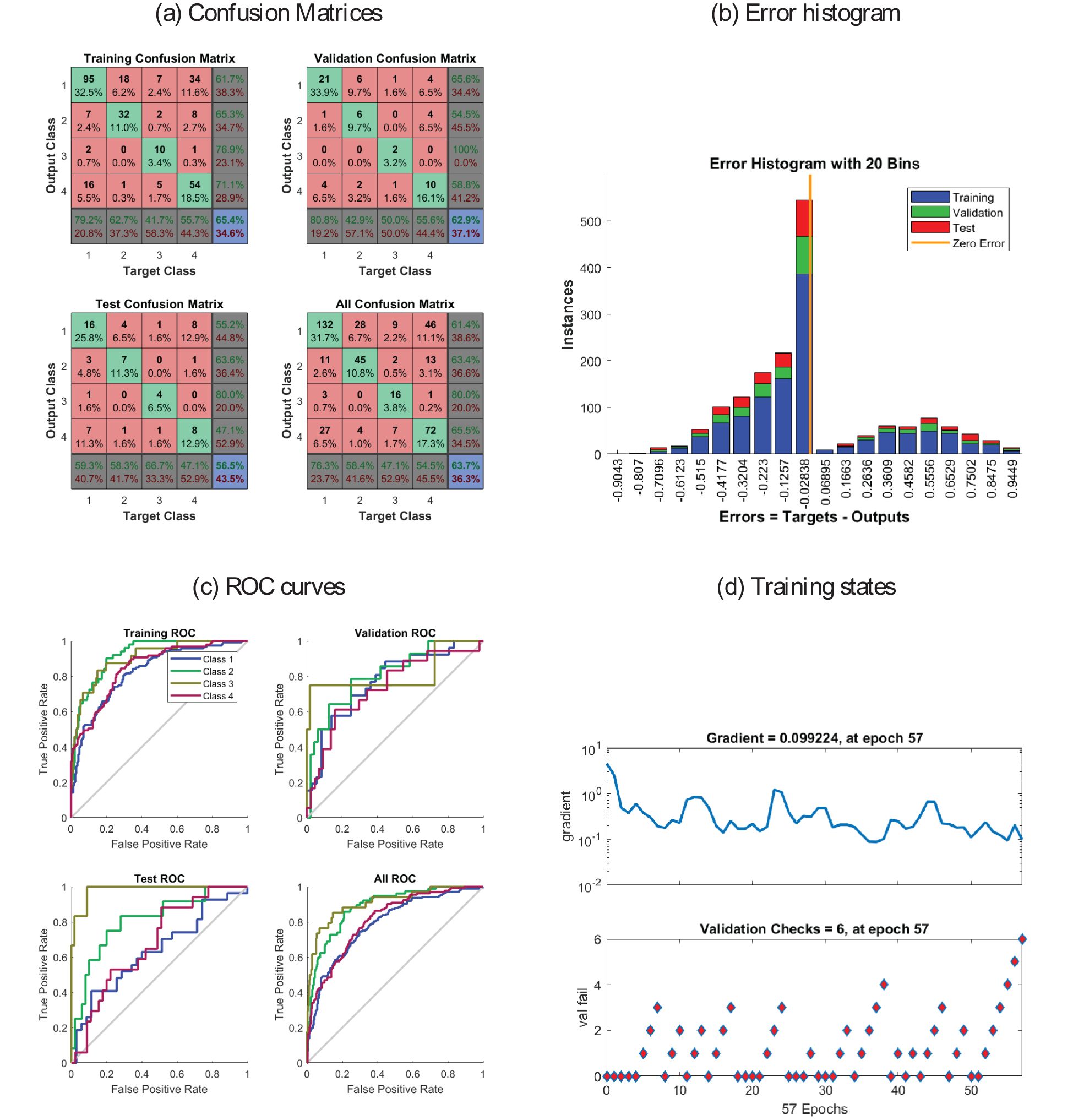
Figure 5. Performance analysis of Neural Network. (a) Confusion Matrices, (b) Error histogram, (c) ROC curves, (d) Training States.
4 Conclusion and future directions
In conclusion, this paper has presented a novel dataset that aims to facilitate (1) RPW pest management and (2) the development and evaluation of new machine learning algorithms for pest monitoring. It comprises RGB and thermal images of date palm trees, accompanied by the farmers’ feedback on the health conditions of the trees. The dataset offers valuable insights into the health status of date palm trees, which play a critical role in the assessment of internal damage to the vascular bundles. It provides a way forward to conduct multi-modal analysis in two heterogeneous domains and contains various research challenges for evaluating new algorithms, working in RGB and thermal vision. The current dataset is collected from the Khairpur region; however, we have planned further data collection from Sukkur, Sindh, Pakistan, and then from various date palm farms in Madina, KSA, to add diversity; then, the generalizability will be addressed.
Data availability statement
The datasets generated for this study can be found here: https://figshare.com/articles/dataset/A_Dataset_of_Date_Palm_Trees_Thermal_and_RGB_Images_for_Pest_Management_/25974295?file=53580344.
Author contributions
AN: Conceptualization, Formal analysis, Funding acquisition, Investigation, Methodology, Project administration, Resources, Supervision, Validation, Writing – original draft, Writing – review & editing. MA: Conceptualization, Data curation, Formal analysis, Investigation, Methodology, Resources, Validation, Visualization, Writing – original draft, Writing – review & editing. AM: Conceptualization, Data curation, Investigation, Methodology, Resources, Software, Validation, Writing – original draft. KR: Methodology, Project administration, Resources, Software, Visualization, Writing – review & editing. MS: Funding acquisition, Investigation, Supervision, Validation, Visualization, Writing – review & editing.
Funding
The author(s) declare that financial support was received for the research and/or publication of this article. This research is funded by the Deanship of Scientific Research, Islamic University of Madinah, Madinah, Saudi Arabia.
Conflict of interest
The authors declare that the research was conducted in the absence of any commercial or financial relationships that could be construed as a potential conflict of interest.
Generative AI statement
The author(s) declare that no Generative AI was used in the creation of this manuscript.
Publisher’s note
All claims expressed in this article are solely those of the authors and do not necessarily represent those of their affiliated organizations, or those of the publisher, the editors and the reviewers. Any product that may be evaluated in this article, or claim that may be made by its manufacturer, is not guaranteed or endorsed by the publisher.
Supplementary material
The Supplementary Material for this article can be found online at: https://www.frontiersin.org/articles/10.3389/fagro.2025.1604188/full#supplementary-material
References
Alaa H., Waleed K., Samir M., Tarek M., Sobeah H., and Salam M. A. (2020). An intelligent approach for detecting palm trees diseases using image processing and machine learning. Int. J. Adv. Comput. Sci. Appl. 11, 434–441. doi: 10.14569/IJACSA.2020.0110757
Al-Mahmood A. M., Shahadi H. I., and Khayeat A. R. H. (2023). Image dataset of infected date palm leaves by dubas insects. Data Brief 49, 109371. doi: 10.1016/j.dib.2023.109371
Al-Mulla Y. and Al-Ruehelli A. (2020). “Use of drones and satellite images to assess the health of date palm trees,” in IGARSS 2020–2020 IEEE International Geoscience and Remote Sensing Symposium (Waikoloa, HI, USA: IEEE), 6297–6300. doi: 10.1109/IGARSS39084.2020.9324065
Al-Saad M., Aburaed N., Al Mansoori S., and Al Ahmad H. (2022). “Autonomous palm tree detection from remote sensing images-uae dataset,” in IGARSS 2022–2022 IEEE International Geoscience and Remote Sensing Symposium (Kuala Lumpur, Malaysia: IEEE), 2191–2194.
Alsadik B., Ellsäßer F., Awawdeh M., Al-Rawabdeh A., Almahasneh L., Elberink S., et al. (2024). Remote sensing technologies using UAVs for pest and disease monitoring: a review centered on date palm trees. Remote Sens. 16, 1–20. doi: 10.3390/rs16234371
Ammar A., Koubaa A., and Benjdira B. (2021). Deep-learning-based automated palm tree counting and geolocation in large farms from aerial geotagged images. Agronomy 11, 1458. doi: 10.3390/agronomy11081458
Ashraf M., Sarim M., and Shaikh A. B. (2017). cellular-cut”-interactive n-dimensional image segmentation using cellular automata. Int. J. Pattern Recognition Artif. Intell. 31, 1754017. doi: 10.1142/S0218001417540179
El-Habbab M. S., Al-Mulhim F., Al-Eid S., Abo El-Saad M., Aljassas F., Sallam A., et al. (2017). Assessment of post-harvest loss and waste for date palms in the kingdom of Saudi Arabia. Int. J. Environ. Agric. Res. 3, 1–11. doi: 10.25125/agriculture-journal-IJOEAR-MAY-2017-7
Hamaidi H. (2019). Date palm data: Images of healthy leaves, brown spots disease and white scale infection.
Nadeem A., Ashraf M., Mehmood A., Siddiqui M. S., Almoamari H., and Abbasi Q. H. (2023). “Identification of damaged date palm tree in a farm using iot-based thermal image analysis,” in 2023 International Conference on Computer, Information and Telecommunication Systems (CITS) (Genoa, Itlay: IEEE), 1–7.
Namoun A., Alkhodre A. B., Abi Sen A. A., Alsaawy Y., and Almoamari H. (2024). Dataset of infected date palm leaves for palm tree disease detection and classification. Data Brief 57, 110933. doi: 10.1016/j.dib.2024.110933
Nationmaster (2020). Top Countries in Dates Production. Available online at: https://www.nationmaster.com/nmx/ranking/dates-production (Accessed March 30, 2025).
Keywords: date palm tree dataset, smart agriculture, RPW infestation, thermal images, AI in agriculture
Citation: Nadeem A, Ashraf M, Mehmood A, Rizwan K and Siddiqui MS (2025) Dataset of date palm tree (Phoenix dactylifera L.) thermal images and their classification based on Red Palm Weevil (Rhynchophorus ferrugineus) infestation. Front. Agron. 7:1604188. doi: 10.3389/fagro.2025.1604188
Received: 01 April 2025; Accepted: 28 May 2025;
Published: 01 July 2025.
Edited by:
José Bruno Malaquias, Federal University of Paraíba, BrazilReviewed by:
Silvio Lisboa De Souza Junior, Universidade Federal da Paraíba, BrazilMuheeb Awawdeh, Yarmouk University, Jordan
Copyright © 2025 Nadeem, Ashraf, Mehmood, Rizwan and Siddiqui. This is an open-access article distributed under the terms of the Creative Commons Attribution License (CC BY). The use, distribution or reproduction in other forums is permitted, provided the original author(s) and the copyright owner(s) are credited and that the original publication in this journal is cited, in accordance with accepted academic practice. No use, distribution or reproduction is permitted which does not comply with these terms.
*Correspondence: Adnan Nadeem, YWRuYW4ubmFkZWVtQGl1LmVkdS5zYQ==
 Adnan Nadeem
Adnan Nadeem Muhammad Ashraf
Muhammad Ashraf Amir Mehmood
Amir Mehmood Kashif Rizwan
Kashif Rizwan Muhammad Shoaib Siddiqui
Muhammad Shoaib Siddiqui